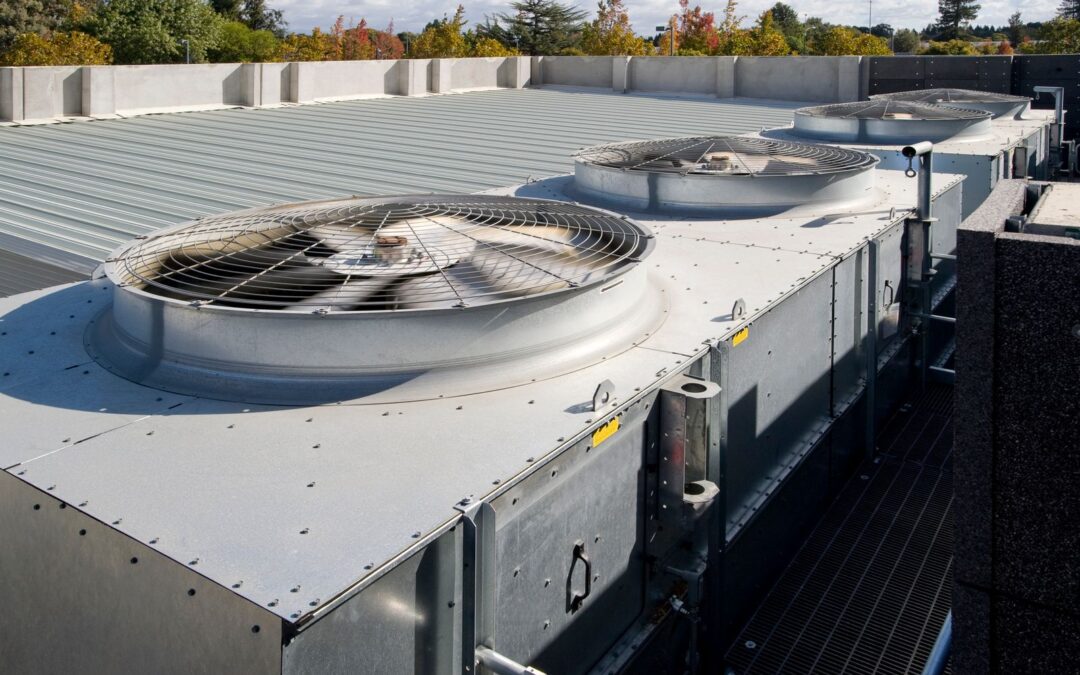What is a cooling tower? An essential part of any HVAC system of course! Cooling towers are tall and open-top structures that are responsible for cooling equipment used for a building or facility’s comfort-cooling purposes.
By getting rid of warmer air and returning colder water back to the chiller, cooling towers are the most effective and least expensive solution to removing the heat generated by your building. Besides, no one wants to spend much time in a place with bad air conditioning! When determining what kind of cooling tower system is best for your building, induced versus forced draft, it comes down to applications and whether a push or a pull is better.
Induced Draft Cooling Towers
Induced draft towers feature a fan (or multiple) located on the top of the cooling tower. The tower allows induced, hot air to move upward and out while water flows downward. By focusing the pressure at the inlet of the fan, the air is pulled through the system. Some water evaporates as it passes through the fill which cools the remaining water going back to the basin. These towers tend to be more compact, requiring less space.
Due to their design, they offer the most efficient cooling solution (using 30%+ less energy) in the long run. Induced systems can also operate in harsher conditions (e.g. acidic or gaseous airstreams and higher temperatures), although these conditions may require more maintenance attention to things like imbalance and vibration. Induced draft cooling tower components include:
- Cooling fill
- Drift eliminators
- Fan and stack
- Outer casing/shell
- Piping
- Spray nozzles
- Water basin
Forced Draft Cooling Towers
The basic difference in forced draft cooling tower setups is that the air-circulating fan is installed at the base and side of the tower. Focusing the pressure at the fan’s outlet allows the air to be pushed throughout the system. The hot water in combination with the counterflow of air then creates heat transfer in the fill. The cleaner ambient air is usually easier on the fan which can mean a longer equipment lifespan.
Forced draft models are less efficient than induced ones due to potential energy loss but still remove low-potential heat that is generated. These towers are popular because they are very powerful while remaining quite affordable. They are also advantageous when you need to address static pressure due to a building’s or enclosure’s ductwork and can also handle high inlet temperatures. Forced draft cooling tower components include:
- Cooling fill
- Drift eliminators
- Fan and stack
- Outer casing/shell
- Water basin
- Water distribution system
Which is Right for You?
Like most things in life, the answer depends. An induced draft cooling tower is set up to eliminate any possibility of discharged air flowing back into the intake area. Forced draft cooling towers, on the other hand, use less power but air recirculation and lost efficiency potential are also present.
| Induced draft benefits | Forced draft benefits |
|---|---|
| Better in cold temperatures More energy efficient Low-absorbed capacity Requires less space | Cost-to-power effectiveness Dry air stream drive Easier maintenance access Lower noise levels |
In addition to installing or replacing a cooling tower, you can also refurbish your existing one to extend your equipment life and investment. No matter what type of cooling tower you have, there are ways that the tower’s energy efficiency can be improved. Here are some things to consider:
- Installing new water piping where needed
- Servicing your tower’s water recycling system
- Increasing cooling cycles (e.g. adjusting from three to six cycles)
Contact Alliance Engineering today to learn more about cooling tower installations, replacements, and upgrades. Also, check out the cooling tower replacement we performed at Rio Vista Apartments here.

